Print Materials for Healthcare Professionals
On This Page
These print materials focus on when it is and is not appropriate to prescribe antibiotics and explain why antibiotic resistance is one of the world’s most pressing public health problems.
These print materials focus on the issue of antibiotic resistance and emphasize the importance of appropriate antibiotic prescribing and use. We encourage you to share these materials widely with your partners and colleagues.
Antibiotic Stewardship Commitment Posters
Written public commitments in support of antibiotic stewardship that are placed in examination rooms have been shown to reduce inappropriate antibiotic prescriptions. These posters can also facilitate patient communication about appropriate antibiotic use. We encourage you to add your healthcare facility logo, healthcare professional photo or signature to any of these posters. Print the posters via your office printers, or send to a professional printer, and post in patient examination rooms. Posters can be printed in color or black and white.
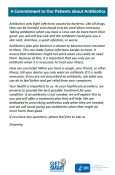
A Commitment to Our Patients About Antibiotics Poster, version 1
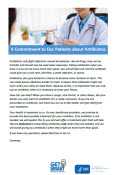
A Commitment to Our Patients About Antibiotics Poster, version 2
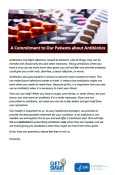
A Commitment to Our Patients About Antibiotics Poster, version 3
Fact Sheets
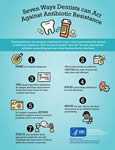
Seven Ways Dentists Can Act Against Antibiotic Resistance
Dental providers play an important role in preventing the spread of antibiotic resistance. This resource highlights some best practices for antibiotic prescribing and use when treating dental infections.
Infographic Details
Seven Ways Dentists can Act against Antibiotic Resistance
Dental providers are uniquely positioned to play a role in preventing the spread of antibiotic resistance. Here are seven simple “how tos” for safe, appropriate antibiotic prescribing and use when treating dental infections.
- MAKE an accurate diagnosis
- When prescribing an antibiotic, CHOOSE the right drug for the right dose and duration.
- USE narrow-spectrum antibiotics for simple infections and preserve broad-spectrum drugs for more complex infections.
- AVOID prescribing antibiotics for viral infections.
- For empiric treatment, REVISE treatment regimen based on patient progress and/or test results.
- KNOW the side effects and drug interactions of an antibiotic before prescribing.
- TEACH your patients about appropriate antibiotic use and emphasize the importance of taking antibiotics exactly as directed.
Centers for Disease Control and Prevention
National Center for Emerging and Zoonotic Infectious Diseases

Checklist for Antibiotic Prescribing in Dentistry
This 1-page, full color 8.5″x 11″ fact sheet describes how dentists can improve antibiotic use in their practices.
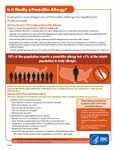
Is it Really a Penicillin Allergy?
Approximately 10% of U.S. patients report having an allergic reaction to a penicillin class antibiotic in their past; however, when evaluated, fewer than 1% are truly allergic to penicillins. This 2-page, full color 8.5″x11″ fact sheet for healthcare professionals describes the evaluation and diagnosis of a penicillin allergy. It includes recommendations that healthcare professionals evaluate patients for true penicillin allergy by conducting a history, physical, and (where appropriate) a skin test and challenge dose. Doing so ensures the patient receives the best care and reduces the risk of antibiotic resistance from unnecessary use of broad-spectrum antibiotics.
- Printer friendly version in color [2 pages]
- Information to share with patients and families: Penicillin Skin Testing: Are You Still Allergic? (Rochester Regional Health) [PDF – 900 KB]
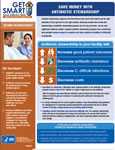
Save Money with Antibiotic Stewardship
This 2-page, full color 8.5″x11″ fact sheet describes how antibiotic stewardship programs and interventions can be a “win-win” for all involved—patients get the right antibiotics at the right time for the right duration and heathcare facilities save lives and significant healthcare dollars.

Preserve the Power of Antibiotics – For Providers
This 2-page, full color 8.5″x11″ fact sheet describes the health impact being seen in healthcare and community settings from overusing antibiotics and outlines steps health care professionals can take to help fight antibiotic resistance.
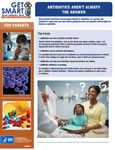
Antibiotics Arent Always the Answer – For Parents
This 2-page, full color 8.5″x11″ fact sheet describes antibiotic resistance and questions parents should ask their child’s healthcare provider to make sure they are getting the best care possible, which might not include an antibiotic.

Antibiotic Resistance – The Global Threat
This 1-page, full color 8.5″x11″ fact sheet describes how antibiotic resistance is happening across the world and global actions to slow resistance.
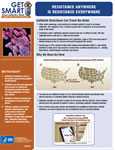
Resistance Anywhere is Resistance Everywhere
This 2-page, full color 8.5″x11″ fact sheet explains how antibiotics are a shared global resource that need to be prescribed and used wisely.
Prescription Pad
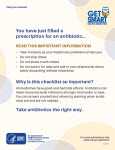
Taking Your Antibiotics Appropriately
This tool is intended for use in pharmacies, clinics, and other healthcare facilities where antibiotic prescriptions are filled. It is intended to promote adherence to antibiotic therapy by citing ways that patients can use antibiotics appropriately. It also raises awareness about why appropriate antibiotic use is important.
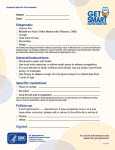
Symptomatic Relief for Viral Illnesses
This tool is designed for healthcare professionals to use with patients. This prescription pad is actually a checklist for healthcare professionals to describe symptomatic relief for a viral illness diagnosis.

New! What is Delayed Prescribing?
This tool is designed for healthcare professionals to use with patients. This prescription pad can be used for patients with conditions that usually resolve without treatment, but who can benefit from antibiotics if the conditions do not improve (e.g., acute uncomplicated sinusitis or mild acute otitis media). Healthcare professionals can apply delayed prescribing practices by giving the patient or parent a postdated prescription and providing instructions to fill the prescription after a predetermined period of time or by instructing the patient to call or return to collect a prescription if symptoms worsen or do not improve. Tip: Put an expiration date (e.g. 3-7 days in the future) on delayed antibiotic prescriptions so that the prescription can only be filled during the observation period and not for a later unrelated illness.
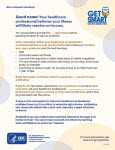
What is Watchful Waiting?
This tool is designed for healthcare professionals to use with patients. This prescription pad can be used to provide symptomatic relief with a clear plan for follow-up if infection symptoms worsen or do not improve.
Sample Letter
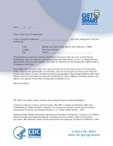
Return to Day Care Letter
When a child has been ill, many day cares will not allow a child to return without an antibiotic treatment. However, not all infections can or should be treated with an antibiotic. This letter explains that the child has a viral illness and will not be receiving antibiotics and should be allowed to return to day care once his or her fever is gone. Healthcare professionals should fill out and sign this letter for parents to give to their child’s day care provider.
- Printer friendly version in color [1 page]
- Printer friendly version in black & white [1 page]
- View brochure in HTML
- Order free small quantities
(CDC-INFO product #999485)
This letter is also available in Spanish.
- Page last reviewed: March 28, 2017
- Page last updated: July 18, 2017
- Content source:


 ShareCompartir
ShareCompartir